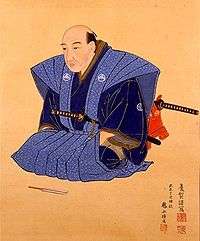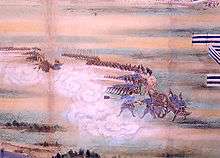Takashima Shūhan
高島秋帆


Right image: Photograph of Takashima Shūhan.
Takashima Shūhan (高島秋帆, 1798–1866) was a Japanese samurai and military engineer.[1] He is significant in having started to import flintlock guns from the Netherlands at the end of Japan's period of Seclusion, during the Late Tokugawa Shogunate.[2] Throughout his life Takashima Shūhan was one of those early Japanese reformists who argued for the modernization of Japan in order to better resist the West. His experience was close to that of Sakuma Shōzan, who was also attacked for adopting Western ideas.[2]
Study of Western firearms

As a child of 10, Takashima Shūhan, the son of Nagasaki officials, was shocked by the violent demands made by the British frigate Phaeton in 1808.[2] Takashima started to study Western guns and, after the 1825 Edict to expel foreigners at all cost ("Don't think twice" policy, 異国船無二念打払令), managed to obtain some weapons through the Dutch at Dejima, such as field guns, mortars and firearms.[2] The guns were known in Japan as Geweer (gun in Dutch) from the 1840s.[2]
Various domains sent students to learn from Takashima in Nagasaki. They came from Satsuma Domain, after the intrusion of an American warship in 1837 in Kagoshima Bay, and from Saga Domain and Chōshū Domain, both southern domains exposed to Western intrusions.[3] These domains also studied the manufacture of Western weapons, and by 1852 Satsuma and Saga had reverbatory furnaces to produce the iron necessary for firearms.[3]
Contacts with the Shogunate
In 1840, Takashima was made a toshiyori, or Senior Administrator, for the city of Nagasaki.[4] From 1840, following the outbreak of the Opium War in China, Takashima appealed to the Shogunate to reinforce Japan's military capabilities.[5] The war in China had made clear that traditional ways were not sufficient to keep the Westerners at bay, and that radical modernization was needed to be able to resist.[6]
Takashima Shūhan established two companies of infantry equipped with guns, as well as one artillery battery, making him Japan's first modern student of Western arms.[2] In 1841, Takashima Shūhan caught the attention of Bakufu official Egawa Tarōzaemon. Takashima made a demonstration with 125 men, using Dutch Rangaku texbooks and Dutch commands for drilling.[2] He demonstrated the use of four cannons and 50 Western guns.[5]
In 1843, Takashima was vindicated, as the Bakufu authorized the usage of Western guns for defenses.[4]
House arrest and rehabilitation

Takashima Shūhan established a school, but was heavily criticized by many, and ended up under house arrest from 1846 to 1853 under charges of subversion and treason.[7] He returned to favour with the arrival of Commodore Perry in 1853,[7] after which he became a military instructor for Bakufu forces in 1856.[3]
In 1862, Takashima Shūhan recommended that Japan equip itself with 200 warships in order to repel the foreign naval threat. This led the Shogunate to authorize each domain to manufacture or purchase their own ships in order to reinforce Japan's naval capabilities.[8]
See also
Notes
- ↑ Nussbaum, Louis-Frédéric. (2005). "Takashima Shūhan" in Japan Encyclopedia, p. 936, p. 936, at Google Books
- 1 2 3 4 5 6 7 Jansen, Marius. (2000). The making of modern Japan, p. 287., p. 287, at Google Books
- 1 2 3 Kornicki, Peter. (1998). Meiji Japan: Political, Economic and Social History 1868-1912, p. 246., p. 246, at Google Books
- 1 2 Cullen, Louis M. (2003). A History of Japan 1582-1941: Internal and External Worlds, p. 160., p. 160, at Google Books
- 1 2 Enb utsu, Sumiko. "Bloomin' good fortune in winter," The Japan Times, February 7, 2002; retrieved 2011-07-05
- ↑ Burt, Peter. (2001). The music of Tōru Takemitsu, p. 5., p. 5, at Google Books
- 1 2 Jansen, p. 288., p. 288, at Google Books
- ↑ The collapse of the Tokugawa bakufu, 1862-1868 Conrad D. Totman p.24
References
- Cullen, Louis M. (2003). A History of Japan, 1582-1941: Internal and External Worlds. Cambridge: Cambridge University Press. ISBN 9780521821551; ISBN 9780521529181; OCLC 50694793
- Jansen, Marius B. . (2000). The Making of Modern Japan. Cambridge: Harvard University Press. ISBN 9780674003347; OCLC 44090600
- Kornicki, Peter. (1998). Meiji Japan: Political, Economic and Social History, 1868-1912. London: Routledge. ISBN 9780415156189; ISBN 9780415156196; ISBN 9780415156202; ISBN 9780415156219; ISBN 9780415156226; OCLC 470242993
- Nussbaum, Louis-Frédéric and Käthe Roth. (2005). Japan encyclopedia. Cambridge: Harvard University Press. ISBN 978-0-674-01753-5; OCLC 58053128